Controlling the Deformation of a Small Coal Pillar Retaining Roadway by Non-Penetrating Directional Pre-Splitting Blasting with a Deep Hole: A Case Study in Wangzhuang Coal Mine
Abstract
:1. Introduction
2. Engineering Background of the Case Study Mine
2.1. Mining and Geological Conditions
2.2. Observation of Roadway Deformation during 6212 Mining Panel Retreating
3. The Reasons for and Control of a Small Coal Pillar Retaining Roadway Deformation
3.1. Contributing Factors for the 6208 Tail Entry Large Deformation
3.2. Deformation Control Measures of Small Coal Pillar Retaining Roadway
- (1)
- Increasing the strength of small coal pillar. By improving the strength of the small coal pillar, on the one hand, the ability of the small coal pillar to resist deformation can be enhanced; on the other hand, this increase can restrain the rotation of the main roof and reduce the rotation angle. Before the mining panel is retreated, the small coal pillar should be grouted or reinforced with anchor cable in advance to improve the strength of the small coal pillar.
- (2)
- Resisting the deformation of the gob side roadway. In order to increase the strength of the roadway support and reduce roadway deformation, a single hydraulic prop is used to strengthen the support ahead before retreating the adjacent mining panel.
- (3)
- Changing the roof structure. The method of directional pre-splitting blasting is used to produce fractures in the roof, so that the main roof fracture line is moved inward to the coal wall side, and the position of the roof fracture line is changed. On the one hand, this can shorten the length of the overhanging beam and reduce the additional load of the main roof; on the other hand, it can make the roof collapse. The filling degree of the gob is thus improved, and the roof support of the gangue in the gob is enhanced. Because of the supporting effect of the gangue in the gob, the rotation and subsidence of the key blocks are reduced, providing a stable stress environment for the roadway along the gob and shortening the period of roof stability.
3.3. Non-Penetrating Directional Pre-Splitting Blasting with a Deep Hole Ahead
3.3.1. Directional Effect of PVC Pipe Punching and Empty Hole in Blasting
3.3.2. Control Principle for Non-Penetrating Fracture Propagation
3.3.3. The Pressure Relief Technology
4. Numerical Simulation
4.1. Global Model and Simulation Scheme
4.2. Analysis of the Modeling Results
4.2.1. Stress Distribution in the Coal Pillar Center
4.2.2. Energy Distribution of the Coal pillar
4.2.3. Vertical Stress Distribution at the Working Face End
4.2.4. Deformation of the 6212 Tail Entry and 6208 Tail Entry
5. Field Application
6. Discussion
7. Conclusions
- (1)
- The lateral rotation of the key rock blocks of the main roof after retreating in the adjacent mining panel and the high compressive strength of the main roof strata caused large deformation of the small coal pillar roadway. Roadway deformation control measures were thus proposed with three goals: improving the strength of the small coal pillar, resisting roadway deformation, and changing the roof’s structure.
- (2)
- Fracture propagation can be effectively controlled by reasonably setting the position of the empty hole for non-penetrating directional pre-splitting blasting. The length of the fracture zone is controlled by changing the number of blasting holes, and the length of the rock mass in the non-penetrating area is controlled by changing the distance between the two adjacent crack arresting holes.
- (3)
- The vertical stress in the center of the coal pillar, the energy accumulation in the coal pillar, the stress at the end of the working face, and roadway deformation are related to the length of the non-penetrating fracture produced by pre-splitting blasting. The number of blasting holes must be selected reasonably to determine the length of the non-penetrating fractures.
- (4)
- The field application results showed that the roof-to-floor and rib-to-rib maximum convergences of the 6208 tail entry were reduced by 608 mm and 733 mm, respectively.
Author Contributions
Funding
Conflicts of Interest
References
- Feng, G.; Wang, P.; Chugh, Y.P.; Zhao, J.; Wang, Z.; Zhang, Z. A coal burst mitigation strategy for tailgate during deep mining of inclined longwall top coal caving panels at huafeng coal mine. Shock Vib. 2018, 2018, 1–18. [Google Scholar] [CrossRef]
- Feng, G.; Wang, P.; Chugh, P.Y. A new gob-side entry layout for longwall top coal caving. Energies 2018, 11, 1292. [Google Scholar] [CrossRef] [Green Version]
- Wang, Q.; Gao, H.; Jiang, B.; Li, S.; He, M.; Wang, D.; Lu, W.; Qin, Q.; Gao, S.; Yu, H. Research on reasonable coal pillar width of roadway driven along goaf in deep mine. Arab. J. Geosci. 2017, 10, 1–17. [Google Scholar] [CrossRef]
- Qian, G.; Shi, W.; Xu, L. Ground Pressure and Strata Control, 2nd ed.; China University of Mining and Technology Press: Xuzhou, China, 2010; pp. 221–230. [Google Scholar]
- Wu, W.; Bai, J.; Wang, X.; Yan, S.; Wu, S. Numerical study of failure mechanisms and control techniques for a gob-side yield pillar in the Sijiazhuang coal mine, China. Rock Mech. Rock Eng. 2019, 52, 1231–1245. [Google Scholar] [CrossRef]
- Li, W.; Bai, J.; Peng, S.; Wang, X.; Xu, Y. Numerical modeling for yield pillar design: A case study. Rock Mech. Rock Eng. 2015, 48, 305–318. [Google Scholar] [CrossRef]
- Huang, B.; Liu, J.; Zhang, Q. The reasonable breaking location of overhanging hard roof for directional hydraulic fracturing to control strong strata behaviors of gob-side entry. Int. J. Rock Mech. Min. 2018, 103, 1–11. [Google Scholar] [CrossRef]
- Huang, B.; Chen, S.; Zhao, X. Hydraulic fracturing stress transfer methods to control the strong strata behaviours in gob-side gateroads of longwall mines. Arab. J. Geosci. 2017, 10, 1–13. [Google Scholar] [CrossRef]
- Bai, Q.; Tu, S.; Wang, F.; Zhang, C. Field and numerical investigations of gateroad system failure induced by hard roofs in a longwall top coal caving face. Int. J. Coal. Geol. 2017, 173, 176–199. [Google Scholar] [CrossRef]
- Peng, S.S. Longwall Mining, 3rd ed.; CRC Press: London, UK, 2020; pp. 87–102. [Google Scholar]
- Liu, S.; Wan, Z.; Zhang, Y.; Lu, S.; Ta, X.; Wu, Z. Research on evaluation and control technology of coal pillar stability based on the fracture digitization method. Measurement 2020, 158, 1–8. [Google Scholar] [CrossRef]
- Li, X.; Zhang, N.; Xie, Z.; Liang, D.; Zhao, Y. Study on efficient utilization technology of coal pillar based on gob-side entry driving in a coal mine with great depth and high production. Sustainability 2019, 11, 1706. [Google Scholar] [CrossRef] [Green Version]
- Zhang, H.; Wan, Z.; Ma, Z.; Zhang, Y. Stability control of narrow coal pillars in gob-side entry driving for the LTCC with unstable overlying strata: A case study. Arab. J. Geosci. 2018, 11, 665. [Google Scholar] [CrossRef]
- Wattimena, R.K.; Kramadibrata, S.; Sidi, I.D.; Azizi, M.A. Developing coal pillar stability chart using logistic regression. Int. J. Rock Mech. Min. 2013, 58, 55–60. [Google Scholar] [CrossRef]
- Qin, S.; Jiao, J.J.; Tang, C.A.; Li, Z. Instability leading to coal bumps and nonlinear evolutionary mechanisms for a coal-pillar-and-roof system. Int. J. Solids Struct. 2006, 43, 7407–7423. [Google Scholar] [CrossRef] [Green Version]
- Shahri, A.A.; Asheghi, R. Optimized developed artificial neural network-based models to predict the blast-induced ground vibration. Innov. Infrastruct. Solut. 2018, 3, 1–10. [Google Scholar]
- Xu, X.; He, M.; Zhu, C.; Lin, Y.; Cao, C. A new calculation model of blasting damage degree—Based on fractal and tie rod damage theory. Eng. Fract. Mech. 2019, 220, 1–12. [Google Scholar] [CrossRef]
- Wang, Y. Study of the dynamic fracture effect using slotted cartridge decoupling charge blasting. Int. J. Rock Mech. Min. 2017, 96, 34–46. [Google Scholar] [CrossRef]
- Yue, Z.W.; Yang, L.Y.; Wang, Y.B. Experimental study of crack propagation in polymethyl methacrylate material with double holes under the directional controlled blasting. Fatigue Fract. Eng. M 2013, 36, 827–833. [Google Scholar] [CrossRef]
- Ma, G.W.; An, X.M. Numerical simulation of blasting-induced rock fractures. Int. J. Rock Mech. Min. 2008, 45, 966–975. [Google Scholar] [CrossRef]
- Jayasinghe, L.B.; Shang, J.; Zhao, Z.; Goh, A.T.C. Numerical investigation into the blasting-induced damage characteristics of rocks considering the role of in-situ stresses and discontinuity persistence. Comput. Geotech. 2019, 116, 103207. [Google Scholar] [CrossRef]
- Yang, R.; Ding, C.; Li, Y.; Yang, L.; Zhao, Y. Crack propagation behavior in slit charge blasting under high static stress conditions. Int. J. Rock Mech. Min. 2019, 119, 117–123. [Google Scholar] [CrossRef]
- He, M.; Gao, Y.; Yang, J.; Gong, W. An innovative approach for gob-side entry retaining in thick coal seam longwall mining. Energies 2017, 10, 1785. [Google Scholar] [CrossRef] [Green Version]
- Wang, Y.; Gao, Y.; Wang, E.; He, M.; Yang, J. Roof deformation characteristics and preventive techniques using a novel non-pillar mining method of gob-side entry retaining by roof cutting. Energies 2018, 11, 627. [Google Scholar] [CrossRef]
- Sun, X.; Gan, L.; Chengwei, Z.; Jianquan, T.; Manchao, H.; Peng, S.; Chengyu, M. Numerical investigation of gob-side entry retaining through precut overhanging hard roof to control rockburst. Adv. Civ. Eng. 2018, 2018, 1–10. [Google Scholar] [CrossRef] [Green Version]
- Gao, Y.; Wang, Y.; Yang, J.; Zhang, X.; He, M. Meso-and macroeffects of roof split blasting on the stability of gateroad surroundings in an innovative non-pillar mining method. Tunn. Undergr. Sp. Tech. 2019, 90, 99–118. [Google Scholar] [CrossRef]
- Wang, Q.; He, M.; Yang, J.; Gao, H.; Jiang, B.; Yu, H. Study of a no-pillar mining technique with automatically formed gob-side entry retaining for longwall mining in coal mines. Int. J. Rock Mech. Min. 2018, 110, 1–8. [Google Scholar] [CrossRef]
- Asheghi, R.; Shahri, A.A.; Khorsand, Z.M. Prediction of uniaxial compressive strength of different quarried rocks using metaheuristic algorithm. Arab. J. Sci. Eng. 2019, 44, 8645–8659. [Google Scholar] [CrossRef]
- Shahri, A.A.; Larsson, S.; Johansson, F. Updated relations for the uniaxial compressive strength of marlstones based on P-wave velocity and point load index test. Innov. Infrastruct. Solut. 2016, 1, 1–7. [Google Scholar]
- Yang, S.; Yang, L.; Gao, T. Theory and Practice of Directional Fracture Controlled Blasting, 1st ed.; Science Press: Beijing, China, 2017; pp. 19–25. [Google Scholar]
- Ghaderi, A.; Shahri, A.A.; Larsson, S. An artificial neural network based model to predict spatial soil type distribution using piezocone penetration test data (CPTu). B Eng. Geol. Environ. 2019, 78, 4579–4588. [Google Scholar] [CrossRef] [Green Version]
- Asheghi, R.; Hosseini, S.A.; Saneie, M.; Shahri, A.A. Updating the neural network sediment load models using different sensitivity analysis methods: A regional application. J. Hydroinform. 2020, 22, 562–577. [Google Scholar] [CrossRef] [Green Version]







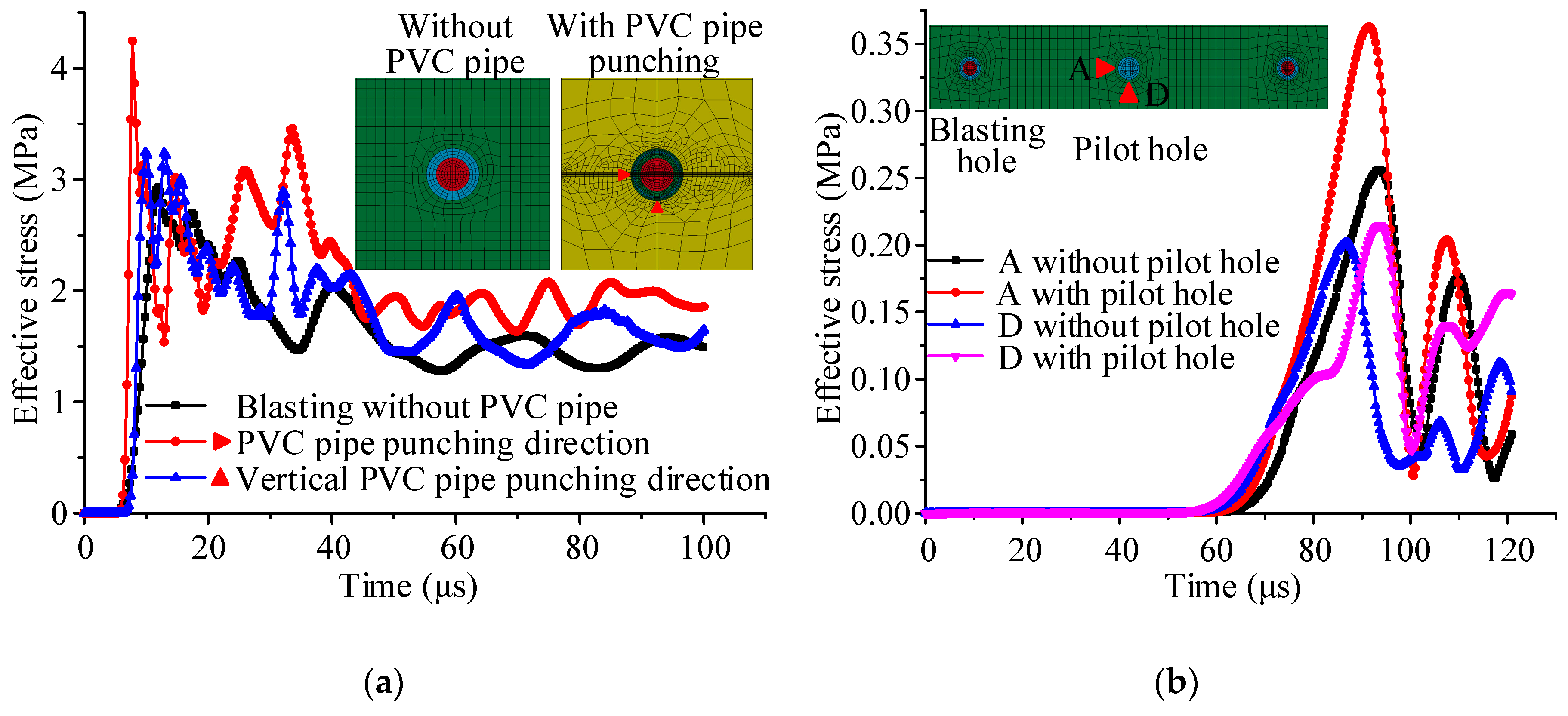
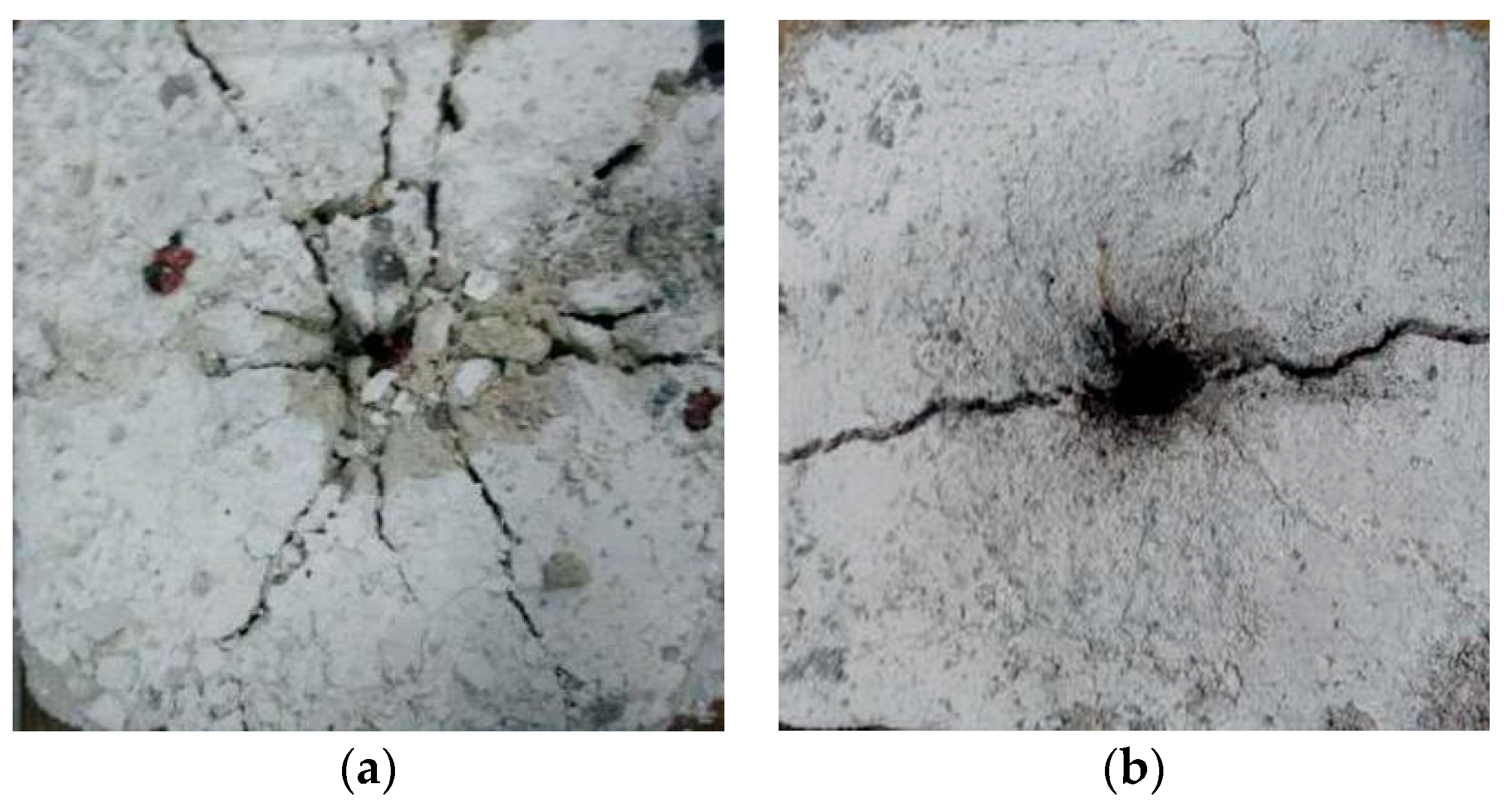



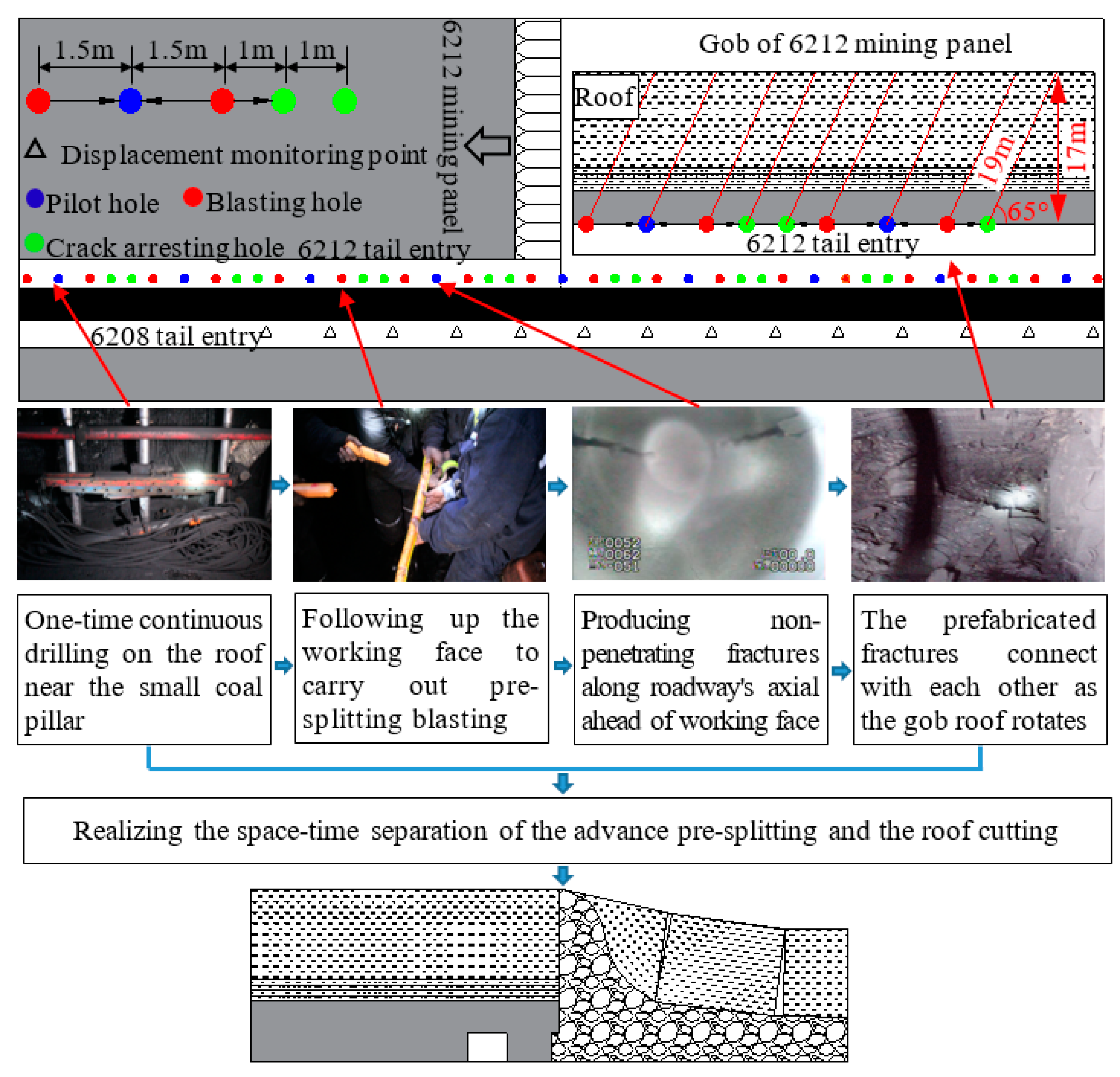

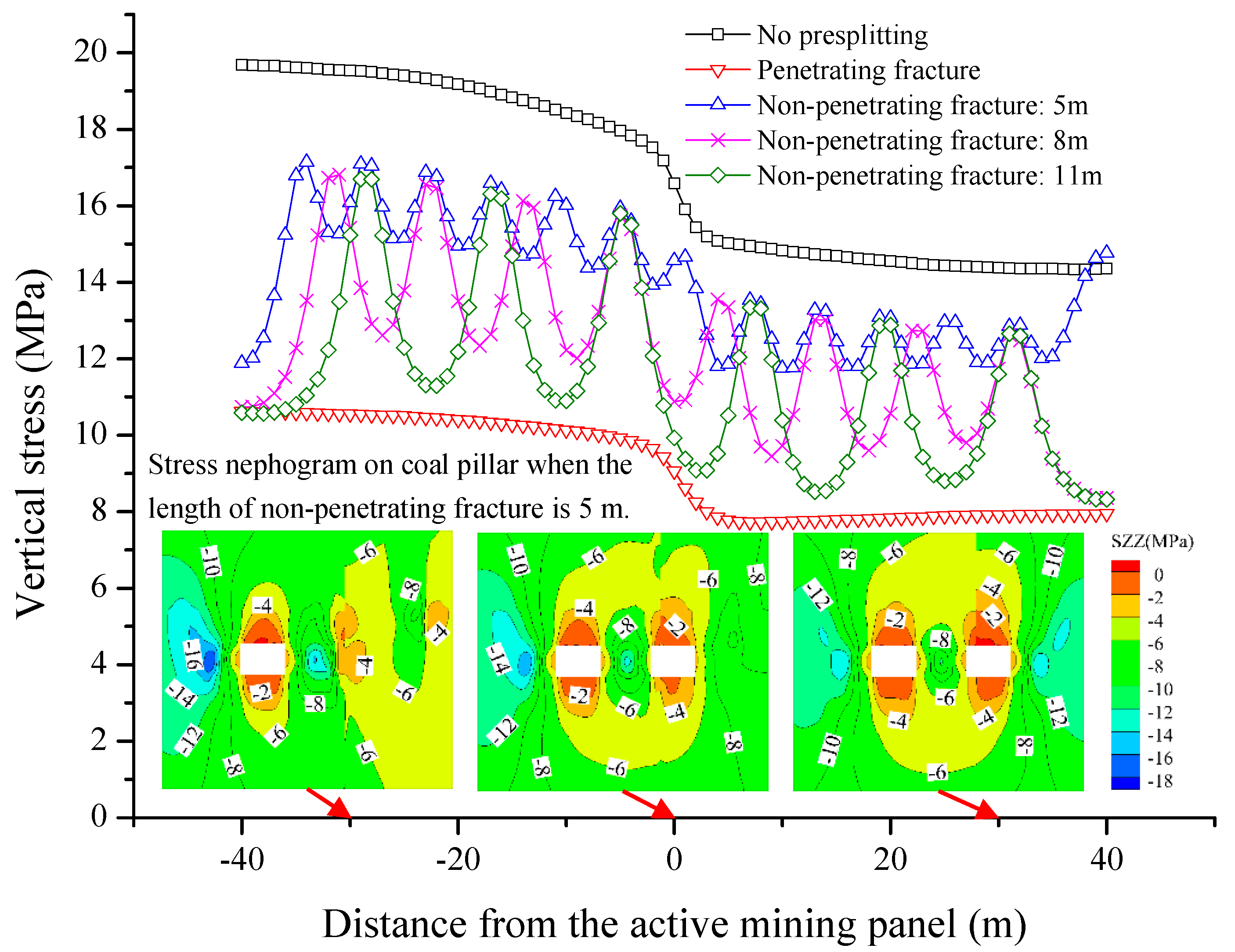
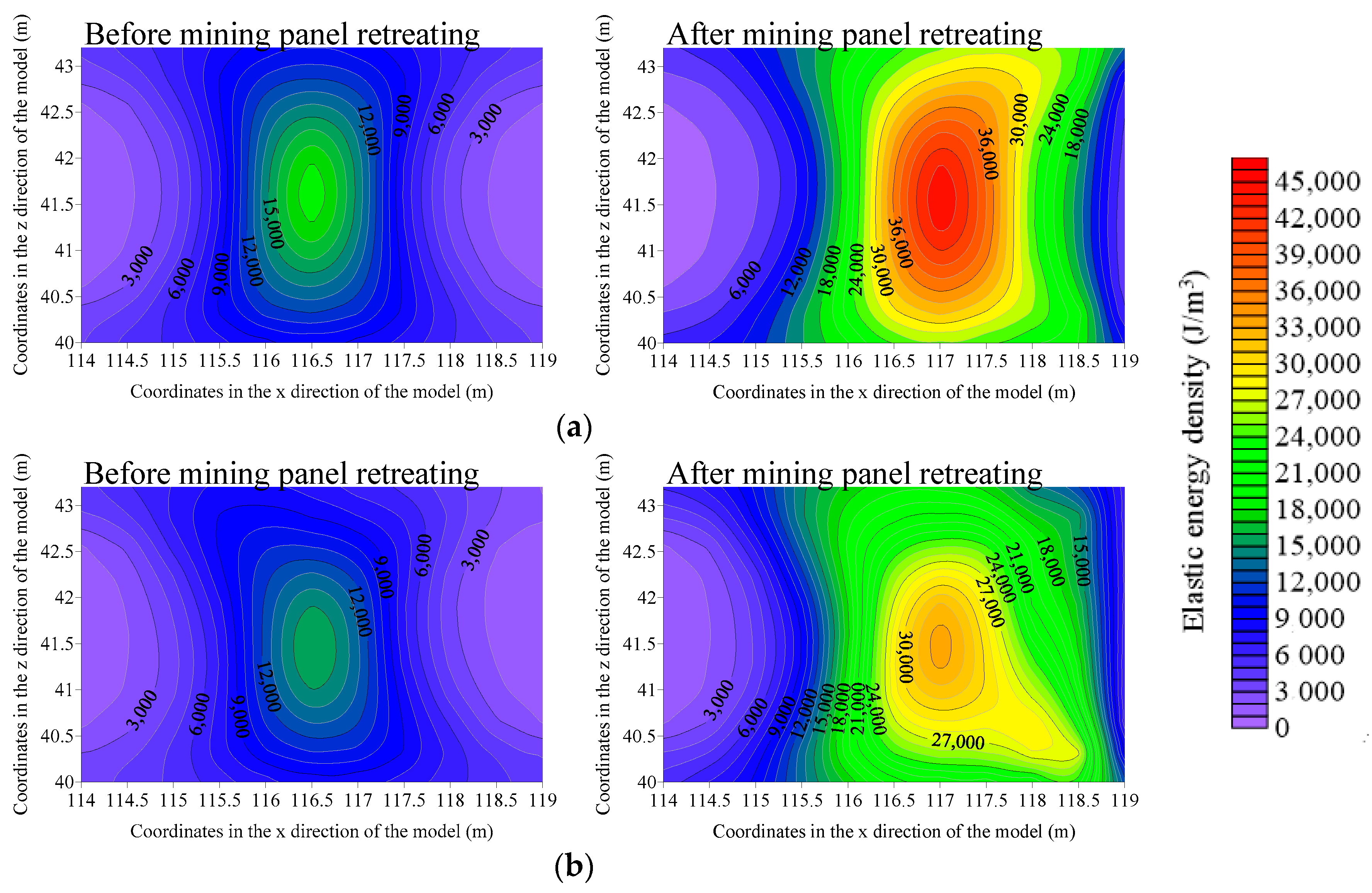

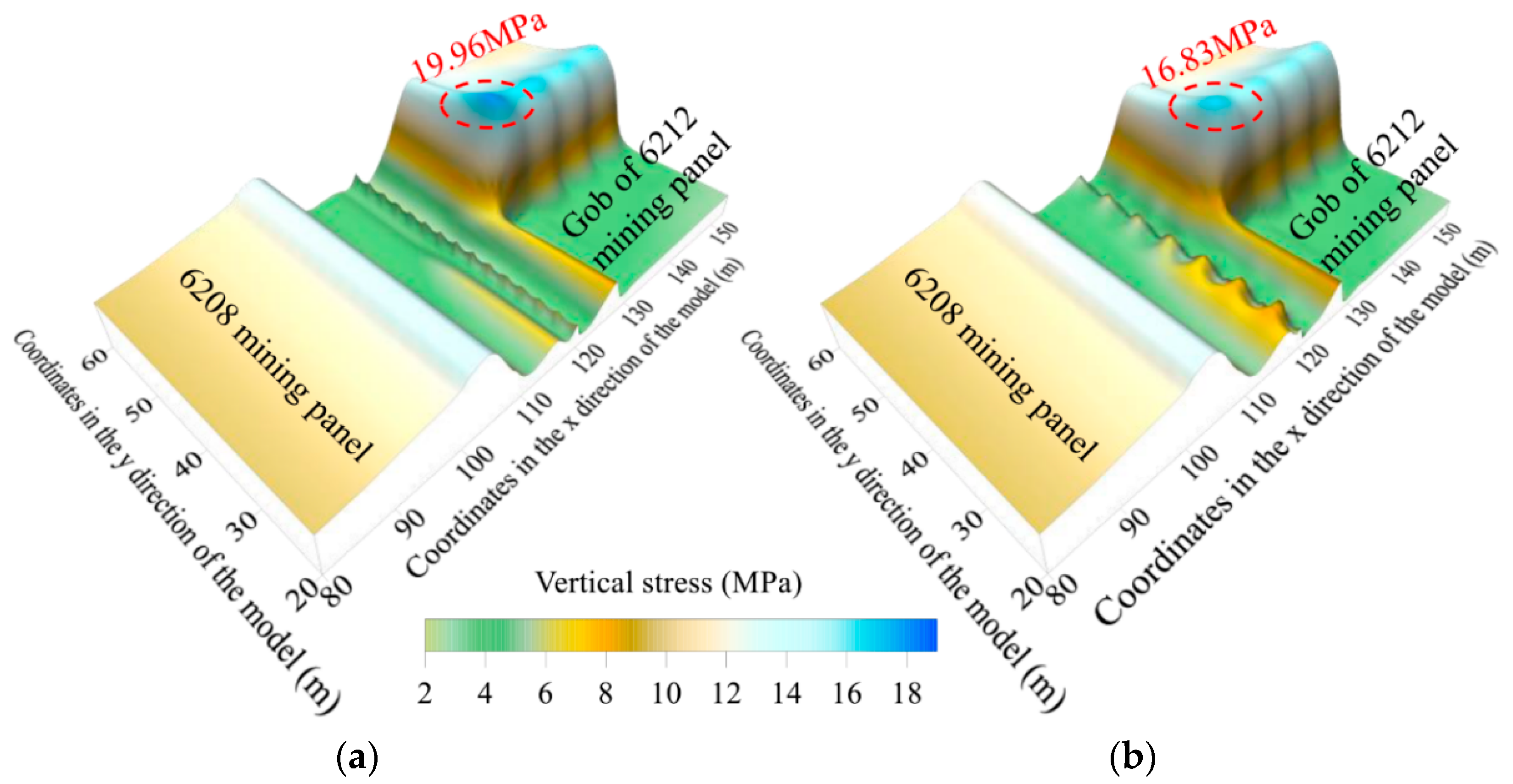


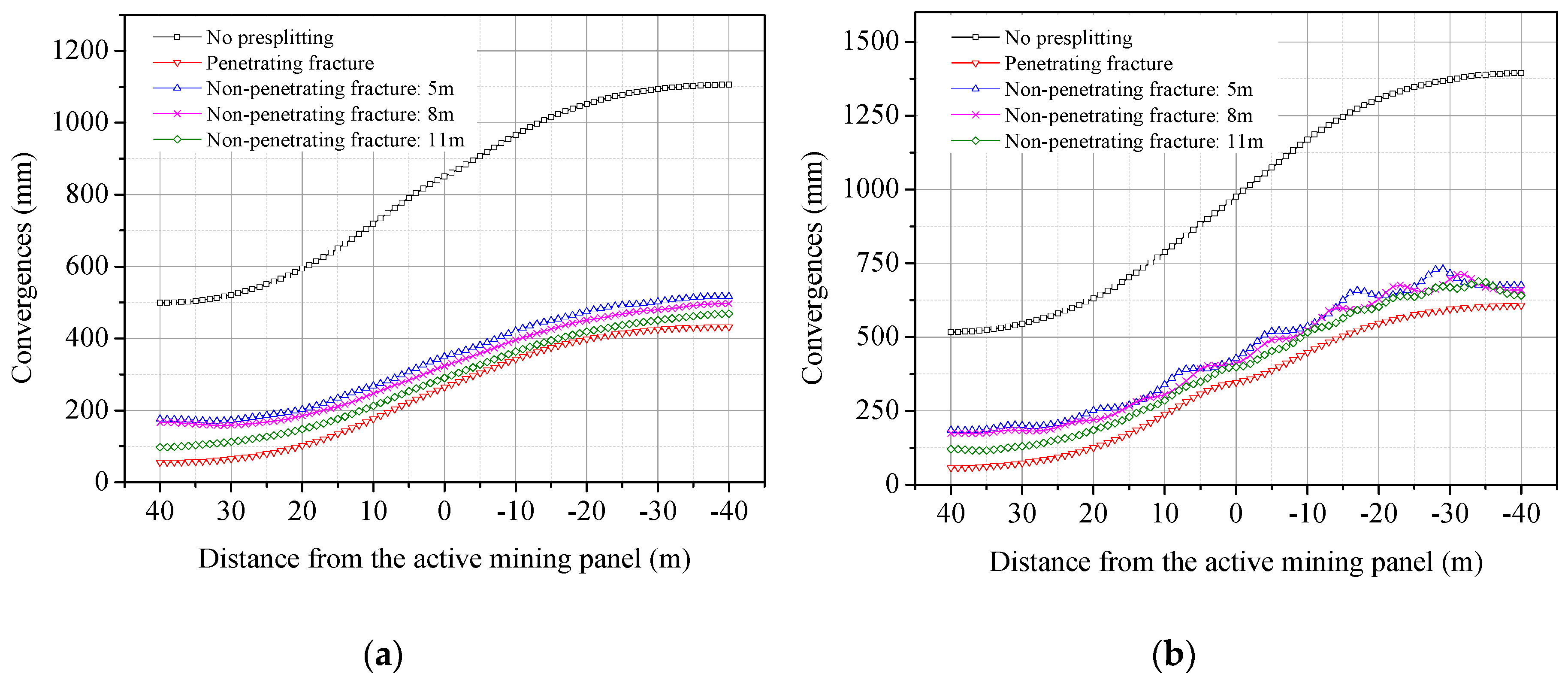
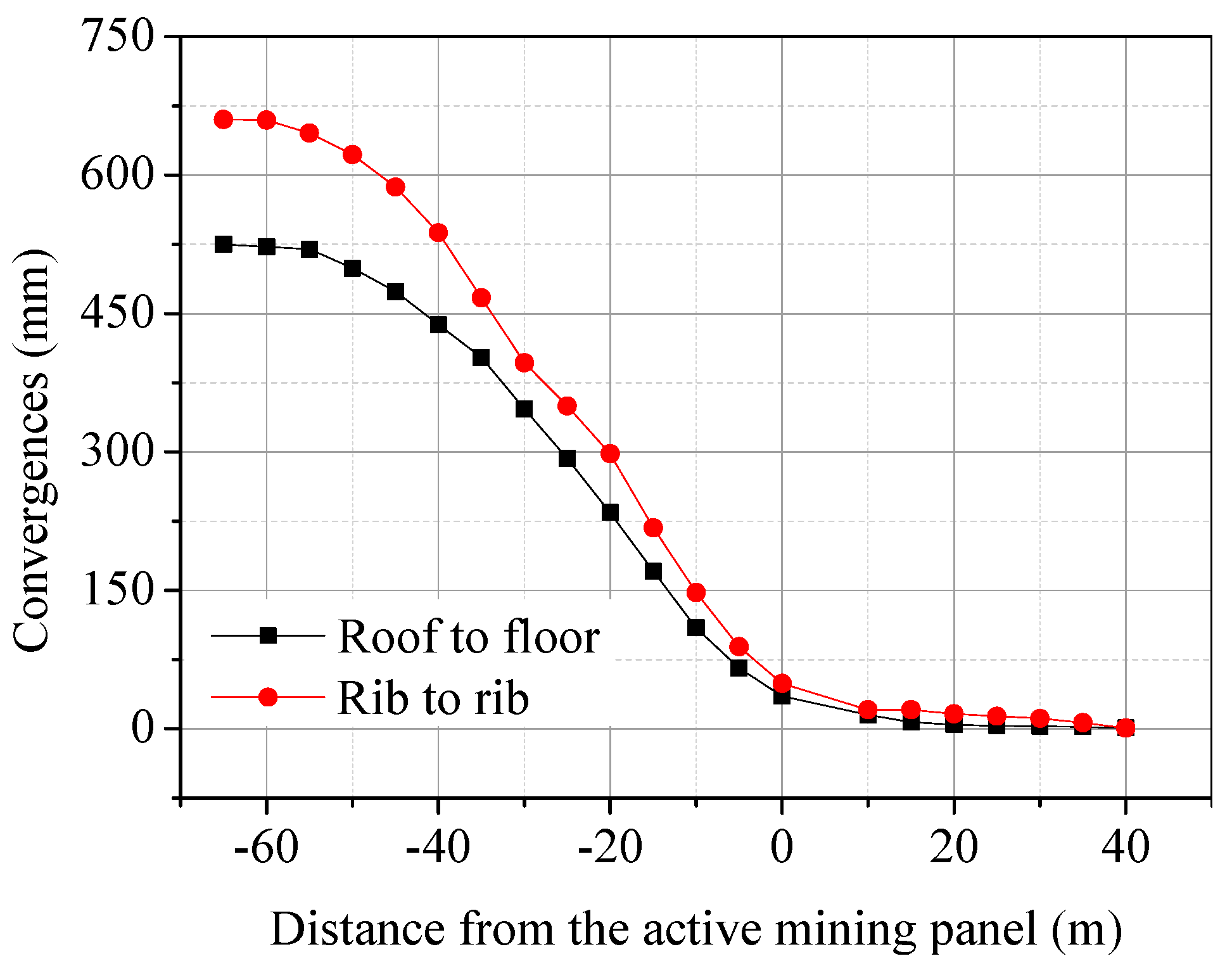
| Material | Density (kg/m3) | Detonation Velocity (m/s) | Chapman–Jouget Pressure (GPa) | Initial Internal Energy (MJ/m3) |
|---|---|---|---|---|
| emulsion explosive | 1250 | 5000 | 14 | 6540 |
| Material | Density (kg/m3) | Young’s Modulus (GPa) | Poisson’s Ratio | Yield Strength (MPa) |
|---|---|---|---|---|
| PVC Pipe | 1300 | 3.6 | 0.38 | 1.2 |
| Rock | 2595 | 55 | 0.27 | 90.05 |
| Air | 1.252 |
| Rock Strata | Bulk Modulus (GPa) | Shear Modulus (GPa) | Cohesion (MPa) | Friction Angle (°) | Density (kg/m3) | Tensile Strength (MPa) |
|---|---|---|---|---|---|---|
| Overlying Strata 6 | 2.36 | 1.53 | 1.89 | 33 | 2420 | 0.89 |
| Overlying Strata 5 | 2.78 | 1.28 | 1.56 | 33 | 2250 | 0.59 |
| Overlying Strata 4 | 2.36 | 1.53 | 1.89 | 33 | 2420 | 0.89 |
| Overlying Strata 3 | 2.78 | 1.28 | 1.56 | 33 | 2250 | 0.59 |
| Overlying Strata 2 | 8.62 | 1.66 | 4.64 | 35 | 2595 | 1.43 |
| Overlying Strata 1 | 2.08 | 1.25 | 1.50 | 32 | 2360 | 0.53 |
| Main Roof | 8.62 | 1.66 | 4.64 | 35 | 2595 | 1.43 |
| Immediate Roof | 2.36 | 1.53 | 1.89 | 33 | 2420 | 0.89 |
| Coal Seam | 2.37 | 1.18 | 1.56 | 28 | 1400 | 0.58 |
| Immediate Floor | 2.78 | 1.28 | 1.56 | 33 | 2250 | 0.59 |
| Main Floor | 7.62 | 1.51 | 3.45 | 36 | 2695 | 1.16 |
| Underlying Strata 5 | 2.78 | 1.28 | 1.56 | 33 | 2250 | 0.59 |
| Underlying Strata 4 | 2.36 | 1.53 | 1.89 | 33 | 2420 | 0.89 |
| Underlying Strata 3 | 7.62 | 1.51 | 3.45 | 36 | 2695 | 1.16 |
| Underlying Strata 2 | 2.78 | 1.28 | 1.56 | 33 | 2250 | 0.59 |
| Underlying Strata 1 | 2.36 | 1.53 | 1.89 | 33 | 2420 | 0.89 |
| Vertical Drilling Deep (m) | 17 | Drilling Dip Angle (°) | 65 |
|---|---|---|---|
| Drilling Length(m) | 19 | Drilling Diameter(mm) | 55 |
| Emulsion Explosive Diameter(mm) | 35 | Fracture Arrest Hole Spacing(m) | 1 |
| Distance Between Fracture Stop Hole and Blasting Hole(m) | 1 | Distance Between Pilot Hole and Blasting Hole(m) | 1.5 |
| Blasting Hole Spacing(m) | 3 | Charge Length(m) | 10 |
| Charge Weight(kg) | 10 | Total Length of PVC Pipe(m) | 10 |
© 2020 by the authors. Licensee MDPI, Basel, Switzerland. This article is an open access article distributed under the terms and conditions of the Creative Commons Attribution (CC BY) license (http://creativecommons.org/licenses/by/4.0/).
Share and Cite
Cheng, S.; Ma, Z.; Gong, P.; Li, K.; Li, N.; Wang, T. Controlling the Deformation of a Small Coal Pillar Retaining Roadway by Non-Penetrating Directional Pre-Splitting Blasting with a Deep Hole: A Case Study in Wangzhuang Coal Mine. Energies 2020, 13, 3084. https://doi.org/10.3390/en13123084
Cheng S, Ma Z, Gong P, Li K, Li N, Wang T. Controlling the Deformation of a Small Coal Pillar Retaining Roadway by Non-Penetrating Directional Pre-Splitting Blasting with a Deep Hole: A Case Study in Wangzhuang Coal Mine. Energies. 2020; 13(12):3084. https://doi.org/10.3390/en13123084
Chicago/Turabian StyleCheng, Shixing, Zhanguo Ma, Peng Gong, Kelong Li, Ning Li, and Tuo Wang. 2020. "Controlling the Deformation of a Small Coal Pillar Retaining Roadway by Non-Penetrating Directional Pre-Splitting Blasting with a Deep Hole: A Case Study in Wangzhuang Coal Mine" Energies 13, no. 12: 3084. https://doi.org/10.3390/en13123084






